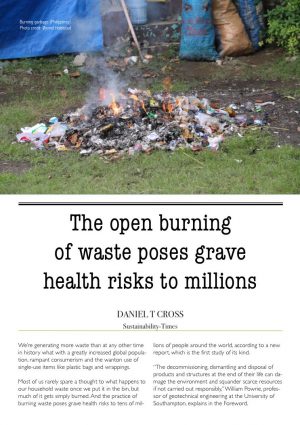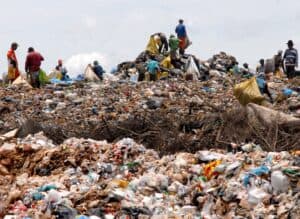
We’re generating more waste than at any other time in history what with a greatly increased global population, rampant consumerism and the wanton use of single-use items like plastic bags and wrappings. Most of us rarely spare a thought to what happens to our household waste once we put it in the bin, but much of it gets simply burned. And the practice of burning waste poses grave health risks to tens of millions of people around the world, according to a new report, which is the first study of its kind.
“The decommissioning, dismantling and disposal of products and structures at the end of their life can damage the environment and squander scarce resources if not carried out responsibly,” William Powrie, professor of geotechnical engineering at the University of Southampton, explains in the Foreword.
“These processes can also be dangerous and harmful to those people involved in them, especially as the waste and processes in question are often displaced to parts of the world least able to manage them safely,” he elucidates.
The research was commissioned by Engineering X, an international collaboration founded by the Royal Academy of Engineering in the United Kingdom, and conducted by experts at the University of Leeds in partnership with the International Solid Waste Association and other organizations. The scientists behind it have found that a quarter, or half a billion tons, of all municipal solid waste generated worldwide is left uncollected while a further 27% of all total waste ends up being mismanaged after it is collected.
“Much of this [waste] is disposed of by open burning. Uncontrolled burning of waste is particularly widespread in low- and middle-income countries where collection and disposal systems are often poor or completely absent,” they explain.

Waste pickers are sorting through garbage in Brazil. (photo: Wikimedia Commons)
To make matters worse, waste is frequently burned close to people’s homes at industrial sites and large dumpsites. “The hazardous cocktail of emissions released into the atmosphere and onto land threatens the environment and the health of those who live and work nearby,” the researchers note.
Their review, they add, “found evidence of emissions from open burning that are classed as persistent organic pollutants, as well as those that are carcinogenic, mutagenic, cause immunological and developmental impairments, and may lead to reproductive abnormalities.”
Across the world, from Southeast Asia to Africa to South America, as many as 11 million so-called waste pickers, including women and children, live at or near garbage dumps eking out a living by sorting through garbage for recyclables, which they then sell for pittances. Often languishing in grinding poverty with their families, the millions of waste pickers worldwide collect and sort for resale anywhere between 20% and 50% of overall generated waste.
They collect more than 90 million metric tons of waste for recycling each year, but as they do so they are routinely exposed to health hazards from the open burning of waste, including toxic materials. Yet despite their contribution to recycling, they are routinely marginalized and shunned in societies, other researchers say.
“They provide services to society free of cost, but their work and rights are not always fully recognised. In some countries, such as Brazil and Colombia they are strongly organised in cooperatives and associations. This enables them to voice their claims and even formally take up municipal waste services,” stress Federico Demaria, a researcher at the Autonomous University of Barcelona in Spain, and Marcos Todt, a PhD student at the Pontifical Catholic University of Rio Grande do Sul in Brazil.
At the same time, their health needs are also largely neglected or ignored. “There is no doubt that the handling of humanity’s waste and its impact on health and safety should be much higher up the global agenda. It beggars belief that we are still using crude and ancient methods of disposal to deal with our 21st century waste problem,” Powrie says.
Costas Velis, an expert at the University of Leeds who cowrote the report, concurs. “Over the past 200 years or so, affluent countries have developed waste management to a point where new research and potential improvements are directed at resource recovery and the development of a circular economy rather than on safeguarding public and occupational health and safety,” Velis says.
“We need to remember that in other parts of the world the disposal of man-made materials, products and structures once they become ‘waste’ at the end of their engineered life can still be a dangerous and harmful business for those involved in the process but much more research and robust data is needed to fully understand the scale of the problem,” he adds.
“In particular, open uncontrolled burning is a huge public health challenge we cannot afford to keep ignoring.”
Originally published
by Sustainability Times
January 08, 2021





